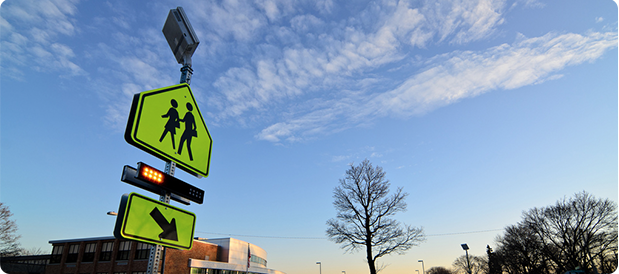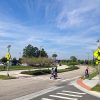Carmanah Rectangular Rapid Flashing Beacon (RRFB) technology becomes a solar-powered ally for students and parents requesting better active transportation infrastructure.

Encouraging children to walk and bike to school is an ongoing project for active transportation advocates, and it isn’t any wonder they are trying so hard. The childhood health benefits of biking and walking abound, not the least of which is combating the juvenile obesity crisis that’s blossoming across the US. And a recent study out of Denmark shows that children who walk or bike to school also have significantly better concentration levels throughout the day than those who don’t.i
So with the benefits obvious and plentiful, what’s the barrier? For many parents, it’s a safety concern. Cities burgeoning with busy streets and non-signalized crosswalks make parents less than comfortable with the thought of letting children get themselves to school.
Parents in Des Plaines, Illinois, aren’t any different, but with over 50% of them reporting that their children ask about walking to school, Des Plaines officials decided it was time to take action. Representatives from the Active Transportation Alliance, the City of Des Plaines, and School District 62 came together to seek solutions that would allay parents’ concerns and help fulfill student requests for active transportation. They identified a particularly troublesome non-signalized crosswalk at the hub of pedestrian activity for four different schools and decided to start there.
The solution to improving the school zone’s accessibility was found in Carmanah’s solar-powered rectangular rapid flashing beacon (RRFB) technology. Supported by FHWA research that shows RRFBs significantly improve driver yield rates over the long term (up to 96% in some cases)ii, Carmanah’s technology felt like the perfect fit.
“This is a non-signalized crossing so it was a perfect location to put in such a feature, such that it can be controlled by people who come here to walk across the street, be it the children, the staff, or the parents,” says Barb Cornew of the Active Transportation Alliance.
In addition to being the ideal treatment for a busy non-signalized crosswalk location, the Carmanah solar-powered RRFB offered the added benefit of being easy to install—a bonus for the Public Works Department.
“One of the things that was nice about this was that it could be installed by our public works crew using existing equipment,” says Derek Peebles, Civil Engineer with the City of Des Plaines. “So in that sense, it was really easy and a quick process. Some of the other improvements are infrastructure improvements like curb extensions and changing the pavement. Those tend to be much more expensive and take a lot longer.”
“One of the things that was nice about this was that it could be installed by our public works crew using existing equipment.”
Beyond quick and easy installation, and immediate improvements to the walkability of this vital school zone, the Carmanah solar-powered RRFBs show the forward-thinking approach of Des Plaines officials when it comes to improving the vibrancy of their community.
“In a leadership position you are always looking to improve the quality of life for the citizens in your community,” says Dan Wilson, Seventh Ward Alderman of the City of Des Plaines. “It is necessary to keep moving forward to use technological advancements, to try new ideas—everything that can improve safety and bring a sense of awareness to our citizens and protect our residents—but first of all our children.”
Download this case study
Watch now
Click the video below to see the Des Plaines, IL, installation:



